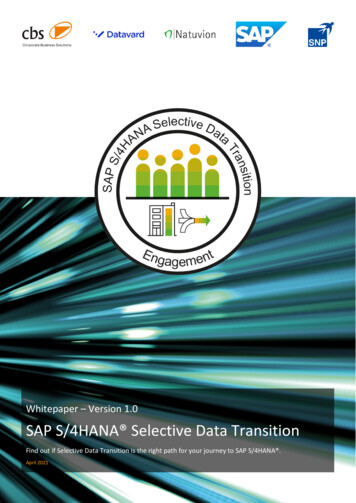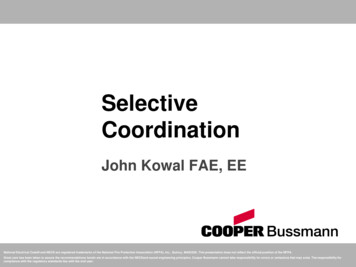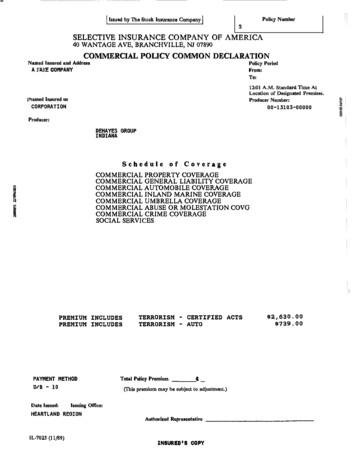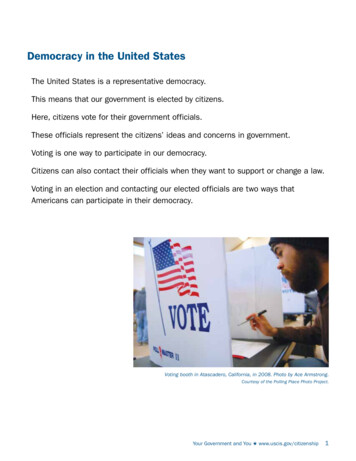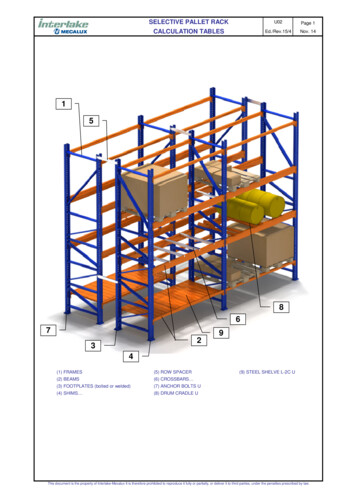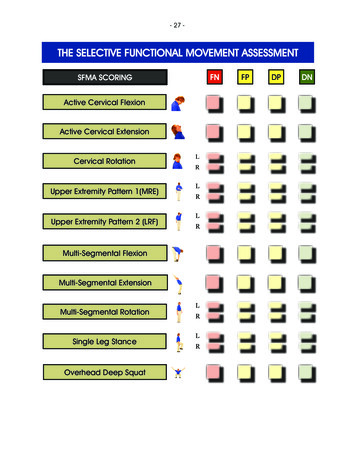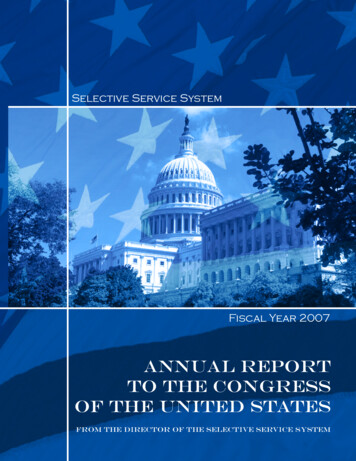
Transcription
Selective Service SystemFiscal Year 2007Annual ReportTo the Congressof the United StatesFrom The Director Of The Selective Service System
COMMOURFOSSSConscientious ObjectorContinuity of Operations PlanCalendar YearDriver’s License LegislationDepartment of DefenseDepartment of Motor VehiclesFederal Information Security Management ActFull-time EquivalentFiscal YearHuman Capital Management PlanInitial Board Member TrainingLearning Content Management SystemMilitary Entrance Processing CommandMemorandum of UnderstandingReserve Force OfficerSelective Service SystemThe FY 2007 Annual Report was produced by the Office of Public and Intergovernmental Affairs,Selective Service Act, Section 10(g).Cover Design and Layout, Laurie Zaleski and Kimberly Galiazzi of Art-Z Graphics, Inc.Selective Service’s Annual Report Project Manager, Jennifer Burke.
Selective Service System Senior StaffAt the end of Fiscal Year 2007William A. ChatfieldDirectorErnest E. GarciaDeputy DirectorRudy G. SanchezGeneral CounselWillie L. Blanding, Jr.Senior Advisor to the DirectorCarlo VerdinoSpecial Assistant to the DirectorWilliam W. ReeseAssociate Director, Financial ManagementScott V. CampbellAssociate Director, Operations and Chief Information OfficerRichard S. FlahavanAssociate Director, Public and Intergovernmental AffairsEdward A. Blackadar, Jr.Associate Director, Support ServicesSusan A. CappoManager, Data Management CenterThomas G. WhiteRegion l DirectorKeith A. ScraggRegion ll DirectorDeborah N. BielanskiRegion lll Director
A Message from the DirectorShaping Future ReadinessOperating the Selective Service System during Fiscal Year 2007 has beenchallenging. Our Nation is engaged in a protracted conflict with terrorism.Resources are diminishing. The world-wide geopolitical environment remainsdangerous and ambiguous, despite the fact that our registration and verificationresponsibilities not only continue, but involve greater workload. To thisoperational environment is added the Administration’s desire to refocus evermore keenly on the registration of young men, with concomitant reductions inoperational readiness.Over the past 34 years, U.S. involvement in several regional conflicts and avariety of peacekeeping endeavors has been relatively short and well withinthe capabilities of our existing forces: Active, Reserve, and National Guard.Consequently, Congress and the President have not had to consider reinstatingconscription or a military draft. Today, the draft mechanism remains in standby status in the form ofa cadre-size Selective Service, and the likelihood of a return to conscription seems remote. Thus, theAgency has reduced its capability to reinstate a national draft in keeping with guidance from the Office ofManagement and Budget, endorsed by the National Security Council and the Department of Defense.Although America does not need a draft today, remaining prepared for the unknowns of tomorrow isboth prudent and necessary. For Selective Service, this means concentrating upon registration compliancewhile continuing to identify ways to achieve greater efficiencies within necessary programs.The pages of this report summarize the recent work of a small Agency that does a big job for America. Atminimal cost, its full-time civilian employees, part-time state directors and Reserve and National Guardofficers, and thousands of unpaid civilian volunteer board members across the Nation who would assurefor America a fair and equitable draft in the future. All in all, today’s Selective Service continues to serveas envisioned by the founders of the all-volunteer military . . . as America’s defense manpower hedge in astill dangerous and uncertain world. A sampling of Agency results indicates measurable achievements. Thirty-seven jurisdictions (states, territories, and the District of Columbia) exchangedriver’s license information with Selective Service, thereby aiding young men to register,comply with federal law, and protect their eligibility for many federal and state programs.This has resulted in 866,082 new registrations for Calendar Year (CY) 2006, as comparedto 858,070 in CY 2005. Three additional jurisdictions are about to exchange driver’s licenseinformation, further aiding registration compliance. The national compliance rate for 18-year-old men has been held constant at 76 percent forCY 2005 and CY 2006.
From CY 2005 through CY 2006, the registration compliance rate for men, ages 18through 25, was maintained at 93 percent. The amount of registrations from automated versus paper sources advanced by sevenpercent, from 81 percent in CY 2005 to 88 percent in CY 2006. This achievement issignificant because the manual processing of paper registrations is more inefficient dueto labor, materials, and time costs.This annual report summarizes significant Selective Service activities, with a focus on its registrationprogram. These activities have been advanced in large measure by the many state legislatures whichhave approved partnerships between the Selective Service and the State Departments of MotorVehicles. State and local support of the national registration requirement is fundamental in ourfederal system of government if Selective Service is to succeed in accomplishing its important job.The Agency cannot perform its statutory duties without grassroot endorsement and active support.In summary, I am pleased and honored to lead the Selective Service System, an independent Agencydefined by integrity and dedicated to upholding the rules of justice and fair play in all of its programs.The leadership of our Nation, together with the public it represents, supports this service organizationwhich is tailored to satisfy the planned needs of our primary client, the Department of Defense (DoD).This support is grounded in the belief that there must always be a shared balance between individualfreedoms and the needs of the community, that public responsibilities mean civic obligations, and thatnational sacrifices are necessary to preserve personal freedoms. Selective Service continues to serveby capitalizing upon its workforce’s knowledge, commitment, and experience for the betterment ofits national programs and the security of the Nation.William A. Chatfield
Table Of ContentsStructure and Purpose . 1Current Activities . 2Budget and Finance . 2Registration . 3Data Management Center . 5Public Awareness and Outreach . 9Information Technology . 16Human and Logistics Resources . 17Operations . 20Readiness Training . 20Alternative Service . 21Planning . 22Field Activities . 23The Future . 23State Directors . 24Registrants by State . 25
Structure and PurposeThe Selective Service System is a small civilian,independent federal agency under the executivebranch operating with permanent authorization underthe Military Selective Service Act (50 U.S.C. App. 451et seq.). It is not part of the DoD; however, it exists toserve the emergency manpower needs of the militaryby conscripting untrained manpower, or personnelwith professional health care skills, if directed byCongress and the President for a national crisis.As a part of that readiness, virtually all men in the U.S.are required to register with Selective Service within30 days of reaching age 18. The current registrationprogram for men born on or after January 1, 1960, ineffect since July 1980, is vital to America. By registeringwith Selective Service, every young man is remindedof his potential obligation to serve our Nation in anemergency. Selective Service is the last link betweensociety at large and today’s all-volunteer Armed Forces.Selective Service is America’s only proven and timetested hedge against underestimating the number ofactive duty and reserve component personnel neededin a future conflict. Its statutory mission also includesbeing ready to administer an alternative civilian serviceprogram in lieu of military duty for men classified asconscientious objectors by a Selective Service board.Registration is important to a man’s future becauseCongress, more than half of the Nation’s statelegislatures, and scores of county and city jurisdictionshave conditioned eligibility for several governmentprograms and benefits upon a man being in compliancewith the federal registration requirement. Theseinclude student loans and grants, government jobs,job training, and U.S. citizenship for immigrant men.Currently, the Agency is minimally staffed and largelydependent upon part-time personnel and volunteersacross the country trained to conduct a draft that wouldbe timely, fair, and equitable in a future national crisis.Under current law, women serve voluntarily in the U.S.Armed Forces, but are not required to register withSelective Service and are not subject to a draft.2007 Annual Report1
Current ActivitiesThe first part of Selective Service’s mission is to beready to mobilize in the event of a congressional andpresidential call for conscription. The Agency spends thebulk of its time on the day-to-day business of its currentoperations. Selective Service secures registrations ofmen 18 through 25, conducts public awareness andoutreach coordination, collects personal information,and staffs the Agency with the personnel to satisfy itsmissions.Budget FinanceSelective Service SystemFY 2007: Obligation of FundsThe FY 2007 BudgetFUNCTIONIn early 2005, Selective Service fell under the HouseAppropriations Subcommittee on Transportation,Treasury, and Housing and Urban Development, theJudiciary, District of Columbia, which included many othersmaller federal agencies. On the Senate side, SelectiveService was under the Transportation, Treasury, theJudiciary, Housing and Urban Development, andRelated Agencies Subcommittee. However, when thenew Democratic Congress took office January 2007, theHouse and Senate Appropriation Committees were eachdesignated 12 subcommittees and Selective ServiceSystem was then moved under the new subcommittee,Financial Services and General Government, for boththe House and Senate.The budget process for FY 2007 was not completedby the September 30, 2006, deadline. By the time theFY 2006 Annual Report was printed and distributed inJanuary 2007, Congress had not voted on the FY 2007budget for the Selective Service System.Selective Service had operated under a fourth continuingresolution, which allowed funding through September30, 2007, (H.J. Res. 20). This resolution became PublicLaw 110-5, signed February 15, 2007.2Personnel Compensation, includingReserve Force Officers (RFOs) . 12,762,043Personnel Benefits . 2,945,084Travel and Transportation of Personnel . 358,465Office, Equipment, Miscellaneous Rentals,Utilities, and Courier Services . 2,040,744Communication Services . 389,572Printing and Reproduction . 760,686Other Services . 2,389,544Supplies and Materials . 245,834Postage and USPS . 1,394,896Furniture and Fixtures, Software, Telecommunications,ADP, and Office Equipment, and Books . 756,854EEO Services and Investigations . 130,270Military Entrance ProcessingCommand (MEPCOM) - Payment to. 529,252TOTAL FOR ALL FUNDS. 24,703,244** Total does not include DoD reimbursement and the balance availablefor unknown obligations.Knowledge Experience CommitmentllAMOUNT
RegistrationRegistration is a critical component of the SelectiveService mission to augment manpower to the DoD inthe event of a national emergency. If a draft becomesnecessary, the public must see that it is fair andequitable. No draft would be fair and equitable unlessall men are treated equally. For that to happen, themaximum number of eligible men must be registered.Thus, Selective Service seeks a 100-percent compliancerate, and continues to develop initiatives to strengthenexisting programs that have increased registrationcompliance across the United States and its territories.By registering, men comply with the federal law andremain eligible for student financial aid, job training,government employment, and security clearance.Immigrant men also protect their eligibility for U.S.citizenship.Anticipated FY 2008 BudgetThe House passed the Continuing Resolution (H.J.Res. 52) on September 26, 2007, the Senate passedit on September 27, 2007, and the President signedit on September 29, 2007. Selective Service beganFY 2008 under this Continuing Resolution, pendingCongressional passage of all appropriations bills.Selective Service anticipates 22 million for FY 2008. Thisis the amount that the House passed on June 28, 2007,and the Senate Subcommittee passed on September12, 2007. According to information received from theOffice of Management and Budget, the Agency’s budgetis currently scheduled to be 22 million. This budgettotal does not account for a potential .5 to 1.5 percentrescission, which would result in a reduction of 100thousand to 330 thousand. Based on the likelihood ofthis rescission, Selective Service anticipates a final FY2008 budget to be 21.7 million.Given the significant budget reduction from FY 2007( 2.8 million), scaling back Agency programs nowbecomes a necessity for FY 2008.For the purpose of consistency with past annual reportsto Congress, this annual report will reference calendaryear when comparing and talking about registrationcompliance rates and compliance statistics. To capturedata of men 18 through 25, Selective Service considersthe data collected for an entire calendar year, forbirthdays January 1 through December 31. All otherregistration comparisons will be discussed in fiscal year,to run parallel with the appropriation funding year.For CY 2006, the Selective Service national estimatedregistration compliance rate was 93 percent for menages 18 through 25 who were required to be registered.Primary factors contributing to registration compliancewere: (1) the enactment in states and territoriesRegistration SourcesFY 2007Registrars0.3%Direct Mail2.2% U.S.P.S.4.9%Compliance8.7%D.L. r DataExchange19.4%Alaska Perm Fund0.1%* About 2 pct. of registrants could not register online, and mailed a registration form.2007 Annual Report3
U.S. Postal Service Mail-Back Programof driver’s license legislation (DLL) encouragingregistration with Selective Service to obtain a driver’slicense, permit, or an identification card; (2) use of onlineregistration through Selective Service’s Web site, www.sss.gov; (3) emphasis on soliciting volunteer SelectiveService high school registrars; (4) additional mailings tostates having the lowest compliance rates with a highregistrant population potential, as well as nationwideto those 19-year-old men who had not registered; (5)increased liaison with U.S. Postal Service offices – theonly universal source of availability of Selective Serviceregistration forms; and, (6) focused, cost-effectiveregistration awareness initiatives and outreach effortsto educational and community leaders and groups.As of September 2007, the Agency received andprocessed nearly 124,000 Selective Service System(SSS) registration forms through the U.S. Postal ServiceMail-Back Program. This most vital program allows manyyoung men who do not have access to the Internet, whodo not have a driver’s license, or who do not yet have asocial security number to register with Selective Serviceat any U.S. Post Office. Most importantly, this programaffords young men in locales throughout the Nation theopportunity to fulfill their Selective Service registrationrequirement and a choice to register through the postoffice. During the fiscal year, the Agency revised itsregistration and change of information forms to meet thelatest Office of Management and Budget/Social SecurityAdministration privacy/identity theft requirements.Steps to Registration ComplianceTo assist in obtaining registration compliance, youngmen may register online through the Internet, orcomplete and return a SSS registration form, or if theform was sent directly by SSS, the man may register bytelephone.In addition, names of registration-age men are obtainedfrom State Departments of Motor Vehicles (DMVs) andthe U.S. Department of Education. State DMV data areobtained from almost every state and territory of the UnitedStates that does not have mandatory DLL supportingthe Selective Service registration requirement. Othersources of data used in the compliance program are theU.S. Postal Service; high schools; the Departments ofDefense, Education, and Transportation; and the Officeof Personnel Management.The Agency continued special direct mailings to improveregistration awareness and compliance rates. Thesemailings were sent to potential registrants in localeswith large populations and estimated low registrationcompliance.4Knowledge Experience Commitmentll
Region Registration EffortsThe Selective Service System’s structure includes threefield regions covering all states, U.S. territories, and theDistrict of Columbia. Region I covers parts of the Midwestand the upper portion of the East Coast, including NewYork City, as a separate entity, and the Nation’s capital.Region II spans southeastern and south central portionsof the United States, Puerto Rico, and the U.S. VirginIslands. Region III spans western United States, therest of the Midwest, Hawaii, Guam, and the NorthernMariana Islands.Region I’s CY 2006 registration compliance rates are 71percent compliance for men born in 1988 (age 18), and89 percent for those born in 1989 (age 19). For drafteligible men 20 through 25, the estimated compliancerate is 94 percent. Region II’s total estimated compliancerates, as reported in January 2007: year of birth (YOB)for 18 year olds, came in at 83 percent; YOB 19, 93percent; and YOB 20 - 25, 97 percent. Region III’sstatistics are YOB 18, 73 percent; YOB 19, 88 percent;and YOB 20 - 25, 96 percent.Data Management CenterThe Agency’s Data Management Center, located inIllinois, processes registrations and maintains thecomputer operations that support the Agency’s mission.Since its inception in September 1981, the Centerprocessed nearly 59 million registrations, 29 millionfile changes to these records, printed and mailed 185million letters and cards, and answered over 20 milliontelephone calls, in addition to other requirementsassociated with peacetime registration programs.In FY 2007, the Center processed over 2.1 millionregistrations and over 768,000 updates to registrantfiles, verified the registration status of over 2.6 millionmen through the Internet Web site, edited 80,000 paperresponses to compliance correspondence, processednearly 1.2 million telephone inquiries, and produced andmailed about 5 million pieces of computer-generatedcorrespondence to acknowledge or promote registration.Such work was accomplished by a seasoned workforce of less than 50 employees, maximizing the use oftechnology obtained through frugal spending over theyears.Most telephone inquiries were from men applying forfederal and state entitlement programs that require proofof registration. Eighty-five percent of calls to the DataManagement Center were processed by an interactivevoice response system. The remaining 15 percent of thecalls were more complex, and were handled by a smallgroup of agents. In addition to answering telephonecalls, this office also processes most paper inquiries tothe Agency.The number of requests for status information letterscontinues to be substantial. These letters are sent tomen who failed to register with Selective Service andare now past their 26th birthdays. These men may bedenied federal student financial aid, federal employmentopportunities, and job training because they failed toregister. The Center prepared and mailed about 50,000status information letters to non-registrants. Such workprovides not only a valuable service to the public, but alsoserves as a critical tool for state and federal agencies inthe administration of their entitlement programs.Even with 83 percent of its FY 2007 registration workloadbeing processed through automation, a small data entrystaff is still required to input nearly 800,000 transactionseach year, which includes manual registrations, registrantfile updates, compliance additions and updates, postoffice returns, and miscellaneous forms. The quality ofthis manual work is impeccable with a 99.970 percentaccuracy rate, directly attributing to an over 98 percentdeliverability rate for mailings to registrants in the primeyear group of vulnerability. Thus, the Agency’s small staffat the Data Management Center remains a vital part ofthe Selective Service System despite the majority ofelectronic transactions.Through the end of FY 2007, the Data ManagementCenter had registration processing systems in placefor 33 states, 3 territories, and the District of Columbia,that implemented driver’s license legislation, as wellas a system for processing registrations for AlaskaPermanent Fund applicants.2007 Annual Report5
Increasing Registration ComplianceThe Driver’s License InitiativeSince the objective of Selective Service registration isto have a fair and equitable return to conscription whenthe need arises, it is necessary to develop initiatives toincrease registration compliance. The most importantinitiative during the past few years has been the driver’slicense initiative, with the Agency working closely withstates and territories that pursue DLL in support ofthe Selective Service registration program. SelectiveService provided such assistance as reviewing draftlegislation, having a working agreement with theAmerican Association of Motor Vehicle Administratorsnetwork, and providing information management relatedtechnical expertise. By the end of FY 2007, 36 states(Alabama, Arizona, Arkansas, Colorado, Delaware,Florida, Georgia, Hawaii, Idaho, Illinois, Indiana, Iowa,Kansas, Kentucky, Louisiana, Maryland, Michigan,Minnesota, Mississippi, Missouri, Montana, NewHampshire, New Mexico, New York, North Carolina,Ohio, Oklahoma, Rhode Island, South Carolina, SouthDakota, Tennessee, Texas,Utah, Virginia, West Virginia,andWisconsin),threeterritories (Guam, MarianaIslands, and Virgin Islands),plus the District of Columbiahad enacted DLL linked tothe registration requirement.As a result, 866,082 menwere registered in CY 2006,compared to 858,070 in CY2005. In lieu of DLL, Alaskaenacted legislation requiringregistration with SelectiveService as a precondition forreceiving proceeds from theAlaska Permanent Fund.Although the states that have enacted this type oflegislation comprise nearly 67 percent of the Nation’sregistrant population potential for 18 year olds and 73percent for draft eligible year of birth groups (20 to 25year olds), it is not enough. Selective Service’s goal isto achieve 100-percent DLL coverage in all states andterritories.For FY 2008, the primary emphasis on improving theoverall registration compliance rate will continue to beassisting states in their efforts to enact driver’s licenselegislation linked to Selective Service registration. Aseach state or territory goes online, the cost savingsfor the Agency will allow reallocation of resources toimprove customer service and the overall preparednessof the Agency.In Region I, ten states andthe District of Columbia haveenacted DLL, which tiesreceiving a state driver’s license, permit, or, in somecases, an identification card, to Selective Serviceregistration. Fourteen of Region II’s 15 states andterritories have enacted DLL. In Region III, 15 stateshave enacted DLL.6Knowledge Experience Commitmentll
Electronic RegistrationCost-effective programs continueto be employed and expandedto help young men register morequickly and easily. A larger portionof the registration process hasbecome automated because of DLL,Internet registration, tape-matchingprograms, and a telephone option.Eighty-three percent of registrationswere received electronically duringboth FY 2007 and FY 2006. Electronicregistrations are more cost-effectiveand provide better customer servicethan paper/card registrations whichare processed manually.With the cooperation of U.S.Citizenship and Immigration Services,immigrant men who are acceptedfor permanent U.S. residence alsobecome registered automatically with Selective Service.Furthermore, men of registration age who completean application for an immigrant visa with the U.S.Department of State are automatically registered. In FY2007, nearly 64,000 men were automatically registeredthrough this interagency agreement, compared to nearly63,000 men in FY 2006.In FY 2007, electronic sources of registrations includedInternet – 471,000, Department of Education – 317,000,Telephonic – 59,000, DoD – 21,000, Department ofLabor – 16,000, and Alaska Permanent Fund – 1,000.Early Submission ofRegistration InformationIn an effort to reach young men who are consideringdropping out of school, as well as to buttress on-timeregistration compliance, the Agency emphasized earlysubmission of registration information. This programallows 17-year-old men to submit registration information“early” through the Internet (www.sss.gov), driver’slicense applications, and other sources. The man’sinformation is held until 30 days before his 18th birthday,at which time his registration record is processed.Registration ReminderMail-Back ProgramAfter the first quarter of FY 2007, the Agency’sRegistration Reminder Mail-back Program wassuspended due to the leadership’s decision to shiftfunds to other priorities. The registration reminderpostcards suggested convenient options for registering.These mailings were sent to potential registrants inmetropolitan areas with large populations and lowregistration compliance.2007 Annual Report7
Increasing RegistrationAwarenessRegistrar ProgramsNearly 87 percent, or18,041, of the Nation’s20,759 high schools had anuncompensatedvolunteeracting as a Selective Servicehigh school registrar, whois authorized to administerand receive registrationsfrom young men. The HighSchool Registrar Programis an effective awarenessprogram that informs malestudents face-to-face aboutthe requirement to registerwithSelectiveService.Because registration is aprerequisite for federal jobopportunities and studentfinancial aid, this programcontinues to reduce the delay and disqualification manystudents could experience if their registration obligationis not fulfilled at the time they turned 18 years old. Theprogram also provides a convenient location for youngmen to register at their high schools. Increased publicawareness and use of online registration reduced theworkload on the uncompensated high school registrars.Selective Service board members and staff participatedin the “Adopt-a-High School” Program to encourageschools to appoint high school registrars and emphasizeonline registration.In Region I, 5,683 high schools, 80 percent of thetotal, participated in the Selective Service High SchoolRegistrar Program. In Region II, the total was 94percent with 5,921 high schools participating in the HighSchool Registrar Program out of a total of 6,322 highschools. South Carolina had 100 percent of registrarsparticipating in the program. In Region III, 88 percent ofthe high schools were participating in the High SchoolRegistrar Program. Wyoming had 100-percent registrarparticipation within their high schools.8The Agency also obtained increased cooperation fromnew uncompensated Selective Service registrars for theFarmworkers Opportunity Program and the WorkforceInvestment Act Program. The result was increasedregistration awareness and compliance by registrationage men participating in these programs. Increaseduse of online registrant verification resulted in improvedcustomer service by providing high school registrars,as well as registrants, student financial aid officers, andWorkforce Investment Act officials, with the ability tocheck and verify a man’s registration.Registration is the GoalThe Selective Service goal is registration, notprosecution. However
Learning Content Management System Military Entrance Processing Command Memorandum of Understanding Reserve Force Officer Selective Service System. Selective Service System Senior Staff At the end of Fiscal Year 2007 William A. Chatfield Director Ernest E. Garcia Deputy Director Rudy G. Sanchez
